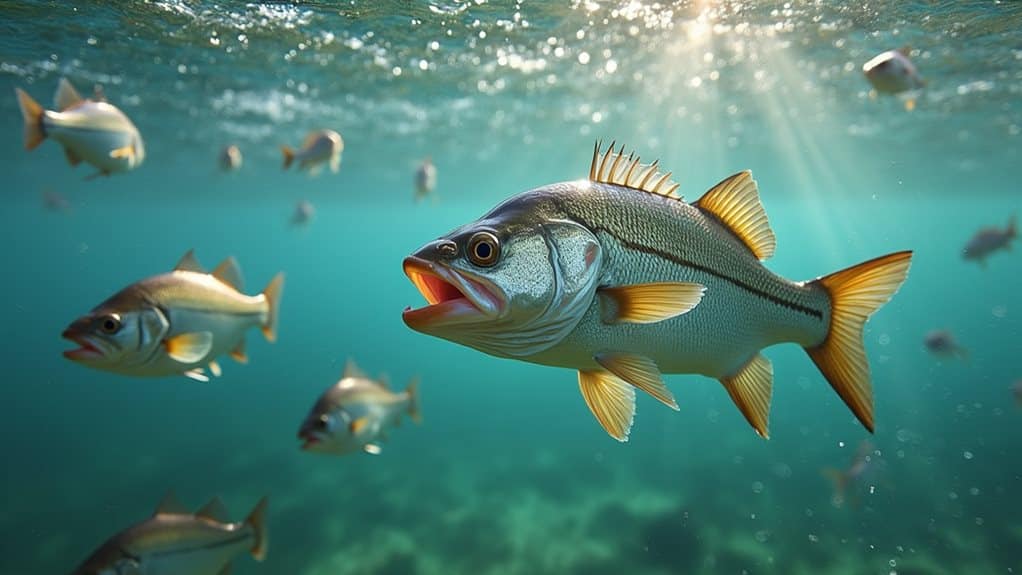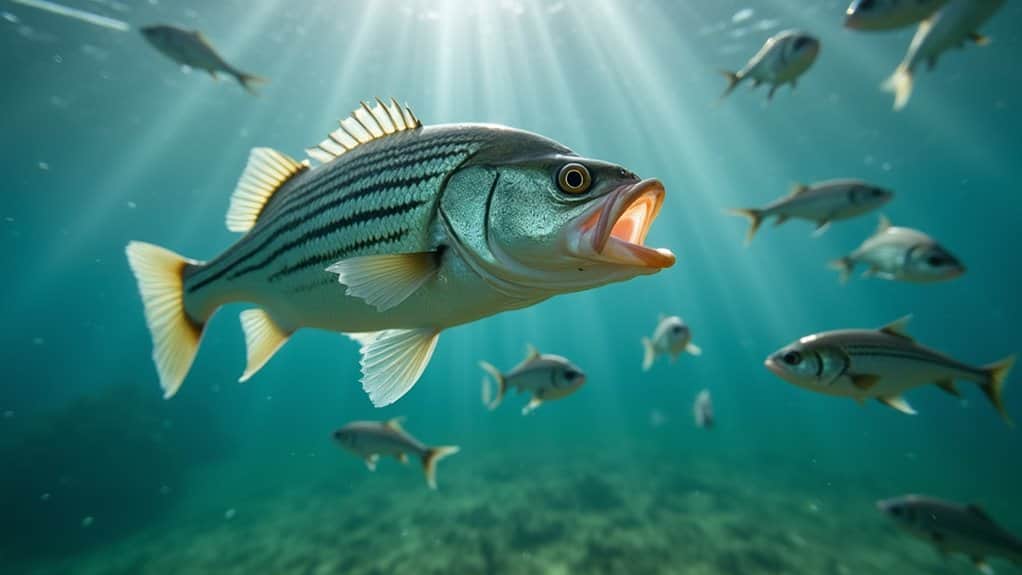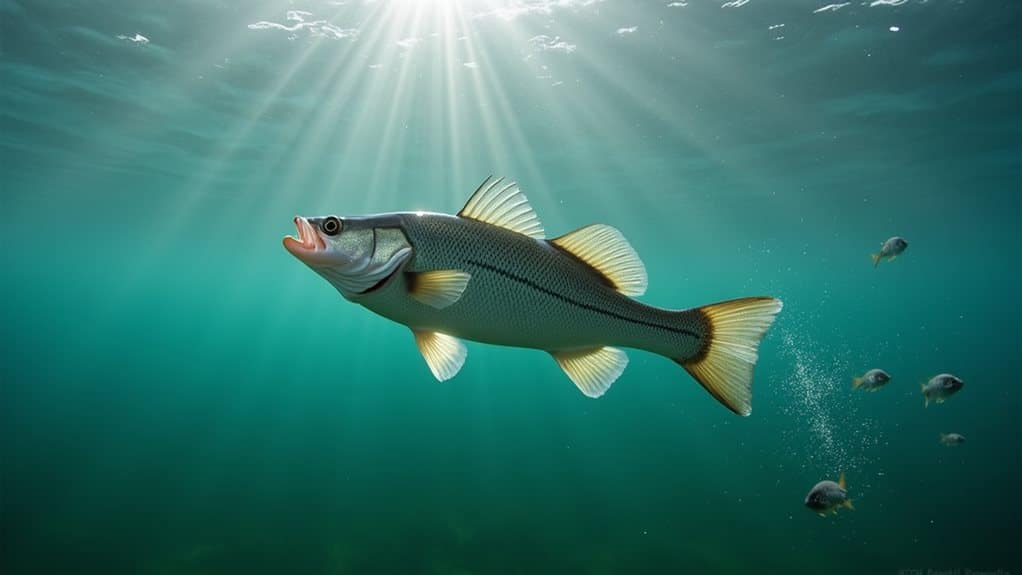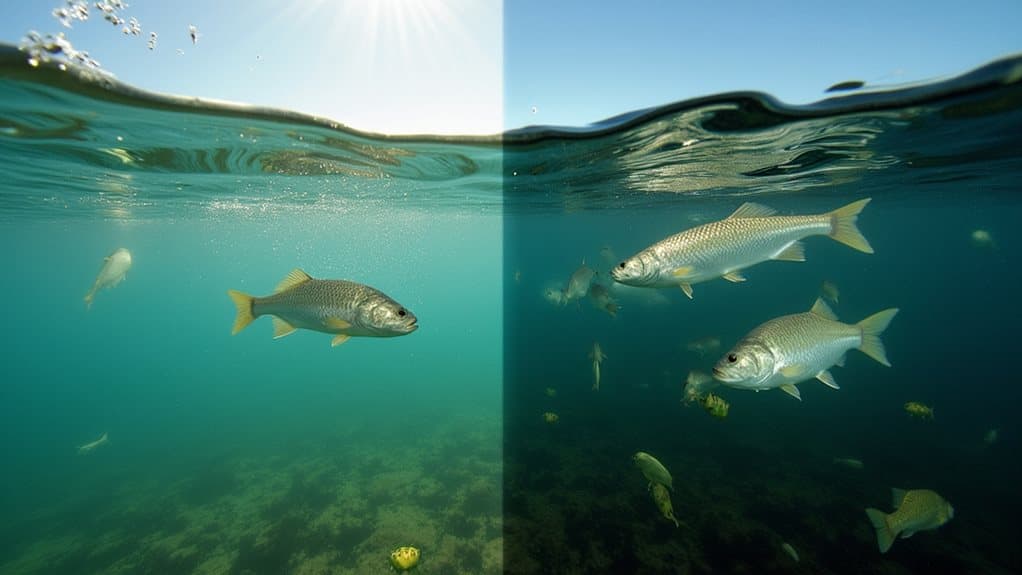White bass are aggressive predators that primarily feed on gizzard shad, yellow perch, and smaller fish species. You’ll find them hunting in coordinated schools during dawn and dusk, often pushing baitfish into confined areas before attacking. While adult white bass focus on fish, younger ones start with zooplankton and progress to larger prey as they grow. Their feeding patterns adapt to seasonal changes and water conditions, revealing complex hunting behaviors worth exploring further.
TLDR
- Adult white bass primarily feed on gizzard shad, yellow perch, and smaller fish species as their main diet.
- Young white bass start with zooplankton, then progress to insects and crustaceans as they grow larger.
- White bass hunt in schools during dawn and dusk, working together to corner prey against physical barriers.
- They adapt their diet seasonally, focusing on shad in summer and moving to deeper waters in winter.
- White bass are opportunistic feeders that target prey near creek mouths, dam tailwaters, and wind-driven lake areas.
Understanding White Bass Feeding Patterns

While White Bass may seem mysterious in their feeding habits, understanding their social patterns and preferred hunting times can greatly improve your success in catching them.
These fish are most active during dawn and dusk, forming large schools that work together to drive prey to the surface. In addition to shad and minnows, they are also known to pursue crappie jigs when competing for food resources.
You’ll find them dispersing across wind-driven lake areas when schools break up to search for food. They primarily target shad and minnows while hunting, making these the perfect live bait choices for anglers.
Natural Diet of Adult White Bass
Predators through and through, adult white bass maintain a primarily carnivorous diet that centers on smaller fish species.
Their hunting instincts are most evident during dawn and dusk, when they’re naturally most active. Freshwater fish like white bass are known to have unique flavors based on their diet and environment.
You’ll find them actively hunting gizzard shad, yellow perch, and similar prey fish, especially near the water’s surface during dawn and dusk.
When food becomes scarce, they’re known to be opportunistic, sometimes even resorting to cannibalism to survive.
The Role of Shad in White Bass Nutrition

Shad represents the cornerstone of a white bass’s diet, playing an essential role in their growth and survival.
You’ll find these predators primarily targeting both threadfin and gizzard shad, with a particular preference for smaller specimens between 1-2 inches.
While shad availability fluctuates seasonally, their presence is vital for maintaining healthy white bass populations across various ecosystems. Additionally, understanding seasonal patterns can help anglers effectively target white bass during their feeding times.
Hunting Techniques and Feeding Behavior
Understanding how white bass hunt and feed can dramatically improve your success in catching them.
They’re pack hunters that push baitfish into confined areas before attacking, and they’ll never hunt alone.
You’ll find them feeding aggressively at the surface when shad are present, and they’re known to strike at anything that mimics their preferred prey, especially small baitfish around 1-2 inches long. Additionally, during certain times of the year, they can be found in shallow flats similar to how bass behave in lakes like Rodman Reservoir.
Seasonal Changes in White Bass Diet

White bass adapt their feeding patterns dramatically as seasons change, shifting from aggressive spring spawning behaviors to more measured winter foraging.
You’ll notice they’re most active during early morning hours in spring and summer, primarily targeting schools of shad and other baitfish in areas with rapid depth changes.
During winter months, they’ll switch to a slower pace and move to deeper waters, where they often focus on crawfish and conserve energy in response to colder temperatures.
Spring Feeding Patterns
During the spring months, these aggressive predators dramatically shift their feeding patterns as they prepare for their annual spawning run.
You’ll find them actively pursuing schools of shad across deep to mid-depth flats and river channels, particularly at dawn and dusk.
They’re most active when water temperatures range between 45°F and 60°F, forming large schools to hunt more efficiently and feed on shad, minnows, and crustaceans.
Summer Diet Transitions
As summer temperatures rise, white bass undergo a significant shift in their feeding patterns, changing to a diet heavily focused on young threadfin shad that begin hatching in late spring.
You’ll find these predators actively hunting in open waters, especially during early morning and late evening hours.
They’re drawn to wind-driven lake sides, points, and coves with quick depth changes, where they’ll chase schools of shad and other small prey fish.
Winter Foraging Behaviors
The cold months bring notable changes to white bass feeding patterns, with these aggressive predators adjusting their behavior to match winter’s challenging conditions.
You’ll find them schooling in deeper waters, conserving energy while still pursuing their preferred prey of shad and minnows.
Though their metabolism slows below 50°F, they’ll actively feed during warm spells, especially near deep structures and power plant discharges.
Where White Bass Hunt Their Prey

White bass display exceptional adaptability when selecting their hunting grounds, choosing specific locations that maximize their chances of catching prey.
You’ll find them actively pursuing food at creek mouths, wind-driven lake sides, and deep main lake points where baitfish congregate.
They’re also drawn to tailwater areas below dams, using these deep holes as ambush sites for unsuspecting prey.
Early Life Stage Feeding Habits
Throughout their development, baby white bass start life with highly specific dietary needs that shape their early survival.
You’ll find these young fish primarily consuming zooplankton, especially species like Daphnia, before shifting to larger prey.
As they grow, they’ll expand their diet to include macro-invertebrates such as chironomid larvae and other aquatic insects, forming schools to feed more efficiently.
Impact of Water Conditions on Feeding

When it comes to feeding patterns, water conditions play a vital role in determining how actively white bass pursue their prey.
You’ll find them feeding most actively in temperatures between 64°F and 73°F, especially in areas with good oxygen levels and flowing water.
They’ll adapt their feeding locations seasonally, moving to deeper waters during summer heat and seeking warmer spots near thermal discharges in winter.
Coordinated Hunting Strategies
Building on how water conditions affect feeding habits, the coordinated hunting behaviors of white bass showcase nature’s extraordinary efficiency in action.
You’ll find these fish forming large schools near rock piles and drop-offs, where they coordinate their attacks on baitfish.
They’re quick to respond to lures, and you can track their movements using electronic devices like sonar, making them easier to locate and catch.
Growth Stages and Dietary Evolution

The fascinating expedition of a white bass’s dietary evolution begins with their earliest days as tiny fry.
You’ll find these fish starting life by consuming zooplankton, then quickly shifting to insects and crustaceans once they reach half an inch.
Ecological Impact of White Bass Feeding
Moving beyond their growth stages, white bass impact entire aquatic ecosystems through their lively feeding behaviors.
You’ll find these intermediate predators actively controlling populations of smaller fish like shad and minnows, while simultaneously serving as prey for larger species.
Their aggressive schooling and feeding habits help redistribute nutrients throughout the food chain, making them essential for maintaining ecosystem balance.
Final Note
Understanding white bass feeding habits will make you a more successful angler. You’ll find these predatory fish primarily targeting shad and other small baitfish, adapting their diet seasonally. They’re opportunistic feeders that’ll also pursue crayfish, insects, and smaller fish species. By matching your lures and fishing techniques to their natural prey and hunting patterns, you’ll increase your chances of landing these aggressive schooling fish.




